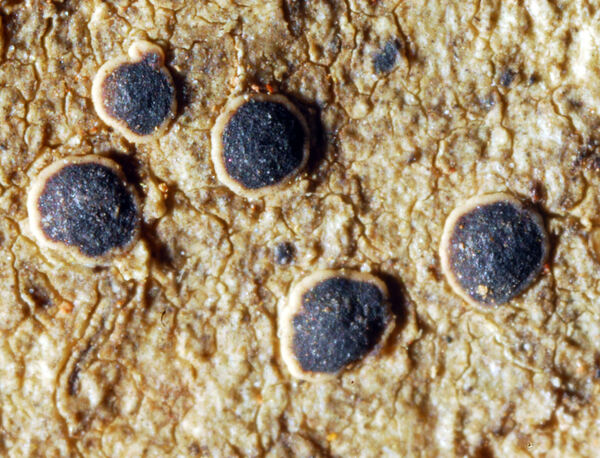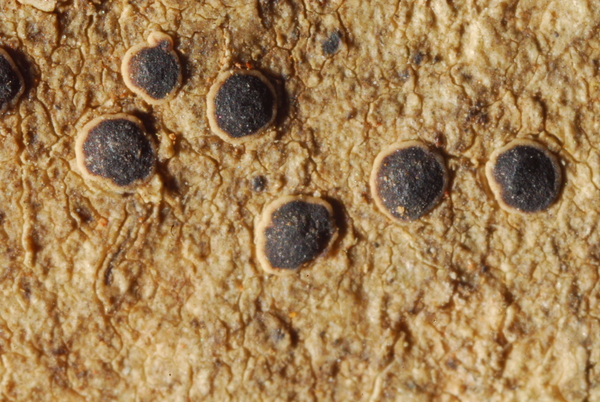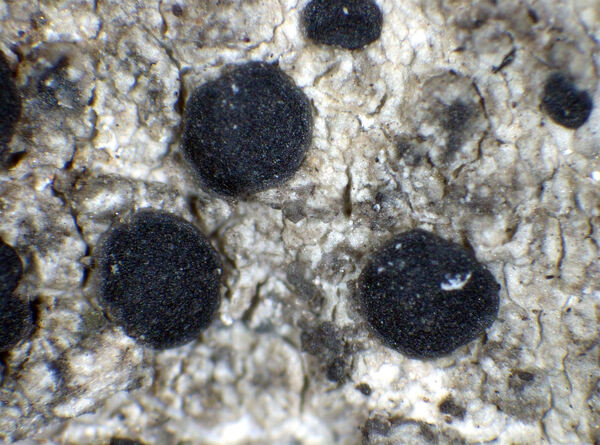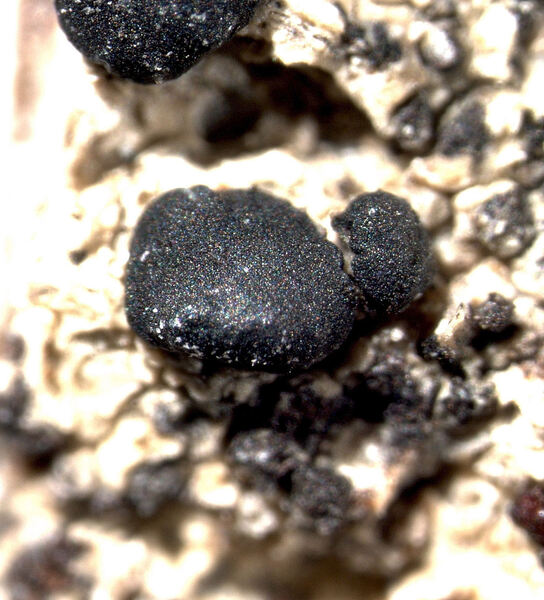Megalaria laureri (Th. Fr.) Hafellner
in Nimis, The Lichens of Italy: 429, 1993. Basionym: Catillaria laureri Hepp ex Th. Fr. - Lichenogr. Scand., 2: 582, 1874.
Synonyms: Biatorina intermixta auct.; Catillaria intermixta auct. non (Nyl.) Arnold ex Glow.; Catinaria intermixta auct. non (Nyl.) P. James; Catinaria laureri (Th. Fr.) Degel.; Gyalecta livida (Mudd) Zahlbr.; Phialopsis livida Mudd
Distribution: N - Frl, Ven (Nascimbene & al. 2005b), Piem, VA (Watson 2014). C - Mol (Caporale & al. 2008, Paoli & al. 2015), Sar (Cossu 2013). S - Camp (Aprile & al. 2003b), Bas (Puntillo & al. 2009, 2012), Pugl (Nimis & Tretiach 1999), Cal (Puntillo 1996).
Description: Thallus crustose, thinly episubstratic, smooth to unevenly warted or finely granulose, whitish grey, ecorticate, often delimited by a black prothallus. Apothecia lecideine, 0.4-1.2 mm across, strongly constricted to subpedicellate, with a flat to convex, black or rarely brown-black, epruinose disc and a usually paler, grey-black, matt, persistent, sometimes finally excluded proper margin. Proper exciple 60-80 μm thick laterally, of radiating, branched and anastomosing, conglutinated hyphae, grey-green to blackish green and N+ purple-red along the outer edge, pale to deep purple-pink and N+ pale orange within, extending below the hypothecium; epithecium patchily blackish green and purple-brown, K+ reddish violet, c. 20 µm high; hymenium colourless or partly pale reddish brown, (50-)65-75(-80) μm high, not inspersed with oil droplets, I+ pale blue; paraphyses lax in K, mostly simple, 1-2 μm thick at mid-level, the apical cells 4-5 μm wide; hypothecium 40-100 μm high, not inspersed with oil droplets, the upper part purple-brown to purple-pink, K+ reddish violet, N+ pale orange, the lower part greenish grey, N+ purple-red. Asci 8-spored, clavate to cylindrical-clavate, the apical dome K/I+ dark blue with a pale, conical-pointed apical cushion (axial mass) never penetrating through the entire d-layer, the wall K/I-, but the thin outer gel K/I+ blue, Bacidia-type. Ascospores 1-septate, hyaline, ellipsoid to ovoid, 12-18(-24) x 5-8 μm. Photobiont chlorococcoid, the cells 6-14 μm wide. Spot tests: thallus K- or K+ pale yellow, C-, KC-, P-. Chemistry: thallus without lichen substances, or with low amounts of atranorin. Note: a mild-temperate lichen found on bark of Quercus and Fagus, more rarely of Abies, in humid forests, certainly declining. It is included in the Italian red list of epiphytic lichens as “Near-threatened” (Nascimbene & al. 2013c).
Growth form: Crustose
Substrata: bark
Photobiont: Trentepohlia
Reproductive strategy: mainly sexual
Most common in areas with a humid-warm climate (e.g. most of Tyrrenian Italy)
Commonnes-rarity: (info)
Alpine belt: absent
Subalpine belt: absent
Oromediterranean belt: absent
Montane belt: extremely rare
Submediterranean belt: extremely rare
Padanian area: absent
Humid submediterranean belt: extremely rare
Humid mediterranean belt: absent
Dry mediterranean belt: absent

Predictive model
Herbarium samples
Growth form: Crustose
Substrata: bark
Photobiont: Trentepohlia
Reproductive strategy: mainly sexual
Most common in areas with a humid-warm climate (e.g. most of Tyrrenian Italy)
Commonnes-rarity: (info)
Alpine belt: absent
Subalpine belt: absent
Oromediterranean belt: absent
Montane belt: extremely rare
Submediterranean belt: extremely rare
Padanian area: absent
Humid submediterranean belt: extremely rare
Humid mediterranean belt: absent
Dry mediterranean belt: absent

Predictive model
| Herbarium samples |
 INDEX FUNGORUM
INDEX FUNGORUM
 GBIF
GBIF
 DOLICHENS
DOLICHENS







